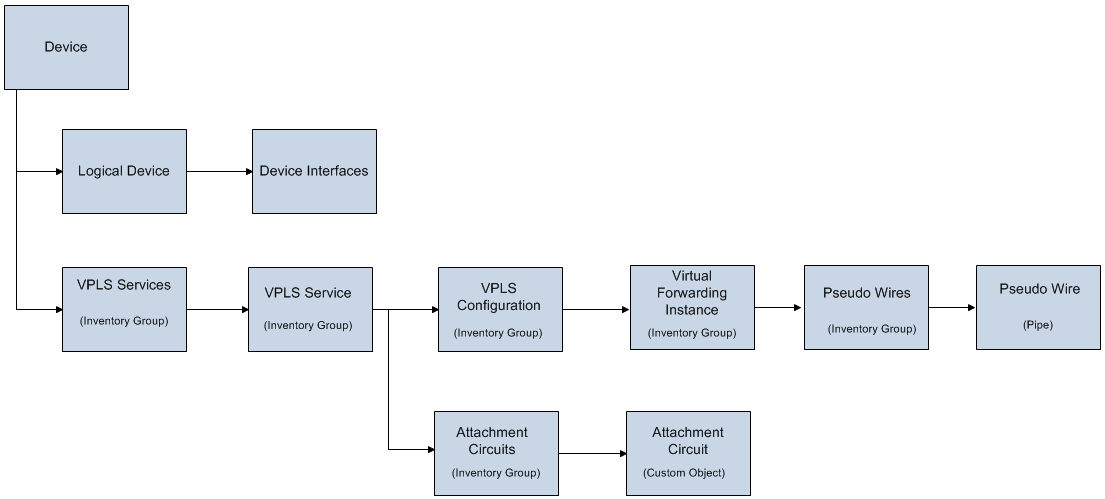3 About the VPLS Reference Cartridge
This chapter describes the functionality and design of the Oracle Communications Network Integrity Virtual Private LAN Service (VPLS) reference cartridge and how to use and build the cartridge.
About Actions and Processors
The VPLS reference cartridge contains the Discover Cisco IOS XR VPLS CLI action.
The Discover Cisco IOS XR VPLS CLI action does the following:
-
Discovers Cisco IOS XR devices in a VPLS service
-
Retrieves information about VPLS services on the Cisco IOS XR devices
-
Models logical device hierarchies that represent the discovered Cisco IOS XR device
-
Models the VPLS service hierarchy
This discovery action inherits all the processors from the Discover Abstract CLI actions. See "About the CLI Cartridge" for more information about the inherited processors.
The Discover Cisco IOS XR VPLS CLI action contains the following processors run in the following order:
-
CLI Property Initializer (inherited)
-
CLI Property Customizer (inherited)
-
CLI Connection Manager (inherited)
Figure 3-1 illustrates the processor workflow of the Discover Cisco IOS XR VPLS CLI action.
Figure 3-1 Discover Cisco IOS XR VPLS CLI Action Processor Workflow
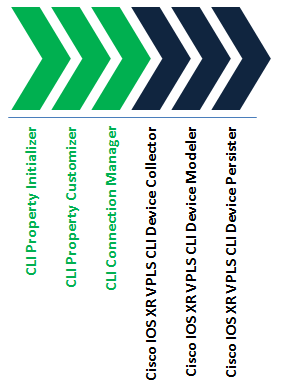
Description of "Figure 3-1 Discover Cisco IOS XR VPLS CLI Action Processor Workflow"
Cisco IOS XR VPLS CLI Device Collector
This processor retrieves the device data and VPLS network data using CLI commands and makes the data available for modeling. This processor runs commands specific to Cisco IOS XR device.
Cisco IOS XR VPLS CLI Device Modeler
This processor models the data collected by the Cisco IOS XR VPLS CLI Device Collector processor into logical device hierarchy and VPLS services.
About Collected Data
This section describes the data that is collected for modeling, listing and explaining each command response.
CLI Commands
This section provides information about the CLI commands and the sample responses that the processors may receive from a device.
show version
This command displays the device type, software version, and host name.
Example 3-1 shows the sample response for the show version CLI command.
Example 3-1 Sample Response for show version Command
Tue Feb 24 01:27:55.783 EST Cisco IOS XR Software, Version 4.2.4[Default] Copyright (c) 2012 by Cisco Systems, Inc. ROM: System Bootstrap, Version 12.00(20100127:230559) [skumarss-33s 1.24] RELEASE SOFTWARE Copyright (c) 1994-2010 by cisco Systems, Inc. rotgsr-2 uptime is 6 weeks, 5 days, 2 hours, 42 minutes System image file is "disk0:c12k-os-mbi-4.2.4/mbiprp-rp.vm" cisco 12410/PRP (7457) processor with 3670016K bytes of memory. 7457 processor at 1265Mhz, Revision 1.2 GSR 12410 200 Gbps 1 Cisco 12000 Series Performance Route Processor 1 Cisco 12000 4 Port Gigabit Ethernet Controller (4 GigabitEthernet) 3 Management Ethernet 1 PLIM_QOS 4 GigabitEthernet/IEEE 802.3 interface(s) 1019k bytes of non-volatile configuration memory. 2000352k bytes of disk0: (Sector size 512 bytes). 46692k bytes of disk1: (Sector size 512 bytes). 65536k bytes of Flash internal SIMM (Sector size 256k). ...........
show interfaces
This command lists all the available interfaces.
Example 3-2 shows the sample response for the show interfaces CLI command.
Example 3-2 Sample Response for show interfaces Command
Wed Feb 25 01:14:42.200 EST Loopback0 is up, line protocol is up Interface state transitions: 1 Hardware is Loopback interface(s) Internet address is 12.12.12.12/32 MTU 1500 bytes, BW 0 Kbit reliability Unknown, txload Unknown, rxload Unknown Encapsulation Loopback, loopback not set, Last input Unknown, output Unknown Last clearing of "show interface" counters Unknown Input/output data rate is disabled. MgmtEth0/4/CPU0/1 is up, line protocol is up Interface state transitions: 1 Hardware is Management Ethernet, address is 0011.bcf1.8965 (bia 0011.bcf1.8965) Description: Management Interface DOT NOT CONFIGURE Internet address is 198.51.100.254/24 MTU 1514 bytes, BW 100000 Kbit (Max: 100000 Kbit) reliability 254/255, txload 0/255, rxload 0/255 Encapsulation ARPA, Full-duplex, 100Mb/s, TX, link type is autonegotiation output flow control is off, input flow control is off loopback not set, ARP type ARPA, ARP timeout 04:00:00 Last input 00:00:03, output 00:00:03 Last clearing of "show interface" counters never 5 minute input rate 0 bits/sec, 1 packets/sec 5 minute output rate 3000 bits/sec, 2 packets/sec 2296633 packets input, 178794962 bytes, 3 total input drops 0 drops for unrecognized upper-level protocol Received 1570634 broadcast packets, 711099 multicast packets 153 runts, 0 giants, 0 throttles, 0 parity 418 input errors, 265 CRC, 0 frame, 0 overrun, 0 ignored, 0 abort 978323 packets output, 68803752 bytes, 0 total output drops Output 237581 broadcast packets, 8 multicast packets 0 output errors, 0 underruns, 0 applique, 0 resets 0 output buffer failures, 0 output buffers swapped out 1 carrier transitions ...........
show l2vpn bridge-domain detail
This command retrieves information about all the VPLS instances running on the device. Following are some of the important attributes that can be extracted from the command response:
-
Bridge Group
-
Bridge Domain
-
Neighbors (PEs only; does not include transit Providers)
-
Pseudo-wire IDs connecting to different neighbors
-
BGP Auto-discovery
-
VFI ID
-
VPN ID
-
VPLS ID
-
Signaling Protocol
-
MPLS Label
-
Remote MPLS Label
-
Route Distinguisher
-
Import Route Target
-
Export Route Target
-
VE ID
-
Advertised VE ID
-
VE Range
-
AS Number
-
L2VPN Router ID
Example 3-3 shows the sample response for the show l2vpn bridge-domain detail CLI command.
Example 3-3 Sample Response for show l2vpn bridge-domain detail Command
Mon Mar 16 06:55:49.990 EDT
Legend: pp = Partially Programmed.
Bridge group: niVpls, bridge-domain: niDomain12k, id: 3, state: up, ShgId: 0, MSTi: 0
Coupled state: disabled
MAC learning: enabled
MAC withdraw: enabled
MAC withdraw for Access PW: enabled
MAC withdraw sent on bridge port down: disabled
Flooding:
Broadcast & Multicast: enabled
Unknown unicast: enabled
MAC aging time: 300 s, Type: inactivity
MAC limit: 4000, Action: none, Notification: syslog
MAC limit reached: no
MAC port down flush: enabled
MAC Secure: disabled, Logging: disabled
Split Horizon Group: none
Dynamic ARP Inspection: disabled, Logging: disabled
IP Source Guard: disabled, Logging: disabled
DHCPv4 snooping: disabled
IGMP Snooping profile: none
Bridge MTU: 1500
MIB cvplsConfigIndex: 4
Filter MAC addresses:
Create time: 08/02/2015 23:08:51 (5w0d ago)
No status change since creation
ACs: 1 (0 up), VFIs: 1, PWs: 1 (0 up), PBBs: 0 (0 up)
List of ACs:
AC: GigabitEthernet0/5/0/0.5, state is unresolved
MAC learning: enabled
Flooding:
Broadcast & Multicast: enabled
Unknown unicast: enabled
MAC aging time: 300 s, Type: inactivity
MAC limit: 4000, Action: none, Notification: syslog
MAC limit reached: no
MAC port down flush: enabled
MAC Secure: disabled, Logging: disabled
Split Horizon Group: none
Dynamic ARP Inspection: disabled, Logging: disabled
IP Source Guard: disabled, Logging: disabled
DHCPv4 snooping: disabled
IGMP Snooping profile: none
Storm Control: disabled
Static MAC addresses:
List of Access PWs:
List of VFIs:
VFI 1 (up)
PW: neighbor 198.51.100.254, PW ID 1, state is down ( provisioned ) (Transport LSP Down)
PW class not set, XC ID 0xff000009
Encapsulation MPLS, protocol LDP
Source address 12.12.12.12
PW type Ethernet, control word disabled, interworking none
PW backup disable delay 0 sec
Sequencing not set
PW Status TLV in use
MPLS Local Remote
-----------------------------
Label 16018 unknown
Group ID 0x3 0x0
Interface 1 unknown
MTU 1500 unknown
Control word disabled unknown
PW type Ethernet unknown
VCCV CV type 0x2 0x0
(LSP ping verification) (none)
VCCV CC type 0x6 0x0 (none)
(Router Label) (TTL Expiry)
-----------------------------
MIB cpwVcIndex: 4278190089
Create time: 08/02/2015 23:08:51 (5w0d ago)
Last time status changed: 08/02/2015 23:09:07 (5w0d ago)
MAC withdraw message: send 0 receive 0
Static MAC addresses:
DHCPv4 snooping: disabled
IGMP Snooping profile: none
VFI Statistics:
drops: illegal VLAN 0, illegal length 0
About Cartridge Modeling
The VPLS reference cartridge models collected data according to the Oracle Communications Information Model. Collected data is modeled into the following entities:
-
LogicalDevice
-
DeviceInterface
-
InventoryGroup
-
Pipe
See Oracle Communications Information Model Reference for more information. Oracle Communications Information Model Reference is located in the Network Integrity Developer Documentation on the Oracle software delivery website.
Figure 3-2 shows how the VPLS reference cartridge models collected data according to the Oracle Communications Information Model.
Field Mapping
The following tables explain the field mappings for each Information Model object.
Table 3-1 Logical Device Mappings
| Information Model Attribute | Information Model Support | Type |
|---|---|---|
|
Description |
Static |
String |
|
Device Identifier |
Static |
String |
|
ID |
Static |
String |
|
Name |
Static |
String |
|
Network Location Entity Code |
Static |
String |
|
Management IP Address |
Dynamic |
String |
|
Native EMS Admin Service State |
Dynamic |
String |
|
Native EMS Name |
Dynamic |
String |
|
Native EMS Service State |
Dynamic |
String |
|
System Object ID |
Dynamic |
String |
Table 3-2 Device Interface Mappings
| Information Model Attribute | Information Model Support | Type |
|---|---|---|
|
Customer Interface Number |
Static |
String |
|
Description |
Static |
String |
|
ID |
Static |
String |
|
Interface Number |
Static |
String |
|
Name |
Static |
String |
|
Nominal Speed |
Static |
String |
|
Vendor Interface Number |
Static |
String |
|
IfAlias |
Dynamic |
String |
|
IfName |
Dynamic |
String |
|
ifPromiscuousMode |
Dynamic |
String |
|
Current MTU |
Dynamic |
String |
|
Supported MTU |
Dynamic |
String |
|
Native EMS Admin Service State |
Dynamic |
String |
|
Native EMS Connector Present |
Dynamic |
String |
|
Native EMS Name |
Dynamic |
String |
|
Native EMS Service State |
Dynamic |
String |
|
Physical Address |
Dynamic |
String |
Table 3-3 Inventory Group (VPLS Service) Mappings
| Information Model Attribute | Information Model Support | Type |
|---|---|---|
|
Name |
Static |
String |
|
Description |
Static |
String |
Table 3-4 Inventory Group (VPLS Configuration) Mappings
| Information Model Attribute | Information Model Support | Type |
|---|---|---|
|
Name |
Static |
String |
|
Description |
Static |
String |
|
BridgeGroup |
Dynamic |
String |
|
BridgeDomain |
Dynamic |
String |
|
VpnId |
Dynamic |
String |
|
BridgeMTU |
Dynamic |
String |
|
PeDiscovery |
Dynamic |
String |
|
BroadcastAndMulticast |
Dynamic |
String |
|
UnknownUnicast |
Dynamic |
String |
|
SplitHorizonGroup |
Dynamic |
String |
|
SignalingProtocol |
Dynamic |
String |
|
VeRange |
Dynamic |
String |
|
VeId |
Dynamic |
String |
|
AdvertisedVEId |
Dynamic |
String |
|
VplsId |
Dynamic |
String |
|
AsNumber |
Dynamic |
String |
|
L2VPNRouterId |
Dynamic |
String |
|
RouteDistinguisher |
Dynamic |
String |
|
ImportRouteTarget |
Dynamic |
String |
|
ExportRouteTarget |
Dynamic |
String |
Table 3-5 Inventory Group (Virtual Forwarding Instance) Mappings
| Information Model Attribute | Information Model Support | Field Type |
|---|---|---|
|
Name |
Static |
String |
|
Description |
Static |
String |
|
Status |
Dynamic |
String |
Table 3-6 Inventory Group (Attachment Circuit) Mappings
| Information Model Attribute | Information Model Support | Field Type |
|---|---|---|
|
Name |
Static |
String |
|
Description |
Static |
String |
|
ID |
Static |
String |
|
Status |
Dynamic |
String |
Table 3-7 Pipe Mappings
| Information Model Attribute | Information Model Support | Field Type |
|---|---|---|
|
Name |
Static |
String |
|
Description |
Static |
String |
|
ID |
Static |
String |
|
Medium |
Static |
String |
|
Transmission Signal Type |
Static |
String |
|
Gap Pipe |
Static |
Boolean |
|
Versioned |
Static |
Boolean |
|
PwType |
Dynamic |
String |
|
PwStatus |
Dynamic |
String |
|
PwClass |
Dynamic |
String |
|
LoopbackInterface |
Dynamic |
String |
|
Protocol |
Dynamic |
String |
|
Encapsulation |
Dynamic |
String |
|
MplsLabel |
Dynamic |
String |
|
RemoteMPLSLabel |
Dynamic |
String |
|
AEnd |
Dynamic |
String |
|
ZEnd |
Dynamic |
String |
Using the VPLS Reference Cartridge
This section describes how to use the VPLS reference cartridge.
Creating a VPLS Discovery Scan
The VPLS reference cartridge does not introduce any new scan parameter groups. Because the VPLS reference cartridge extends the CLI cartridge, the configurable scan parameter groups are those from the CLI cartridge.
VPLS Service Discovery
To discover a VPLS service on a Cisco IOS XR device, create a VPLS discovery scan in the same way that you create a discovery scan for CLI devices. See "Using the CLI Cartridge" for the procedure. When setting the values in the General tab in the Scan Action Parameters area, do the following:
-
From the Select Parameter Group list, select CLI Device Discovery Parameters and enter the required information in the following fields:
-
From the Device Type list, select the type of the device. For example, Cisco Device.
-
From the Service list, select the type of service to be discovered on the device. For example, Virtual Private LAN Service.
-
From the Software Version list, select the operating system of the device. For example, Cisco IOS XR.
-
Discovered Results
Discovered results have a result group for each device.
Figure 3-3 shows sample data for VPLS configuration discovered by the VPLS reference cartridge.
Figure 3-3 Sample Discovered Data for VPLS Configuration
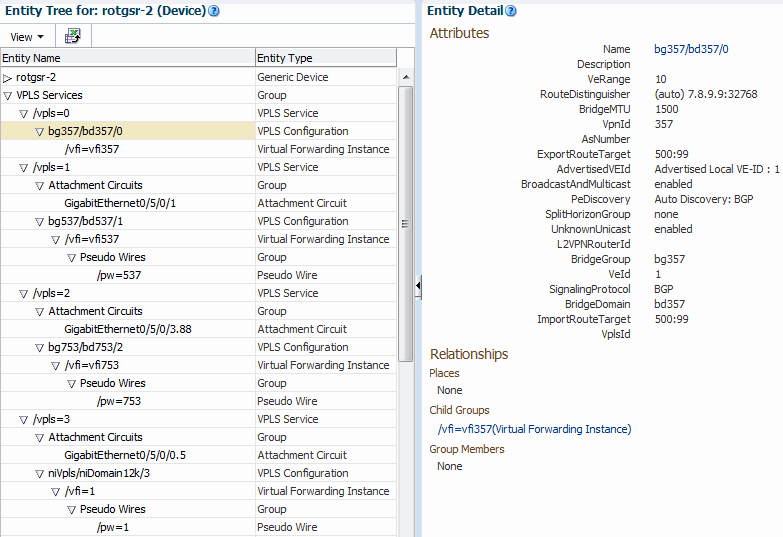
Description of "Figure 3-3 Sample Discovered Data for VPLS Configuration"
Figure 3-4 shows sample data for an attachment circuit discovered by the VPLS reference cartridge.
Figure 3-4 Sample Discovered Data for an Attachment Circuit

Description of "Figure 3-4 Sample Discovered Data for an Attachment Circuit"
Figure 3-5 shows sample data for a virtual forward instance discovered by the VPLS reference cartridge.
Figure 3-5 Sample Discovered Data for a Virtual Forwarding Instance
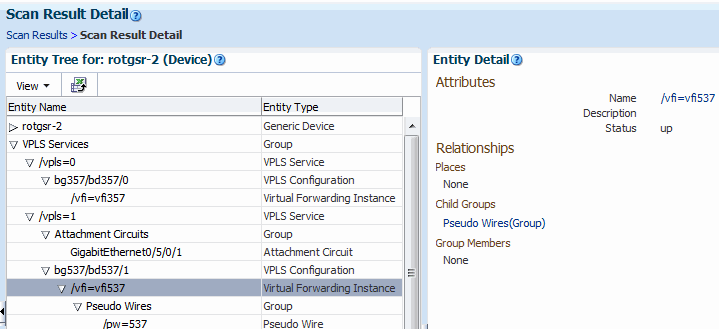
Description of "Figure 3-5 Sample Discovered Data for a Virtual Forwarding Instance"
Figure 3-6 shows sample data for pseudo wire discovered by the VPLS reference cartridge.
Figure 3-6 Sample Discovered Data for a Pseudo Wire
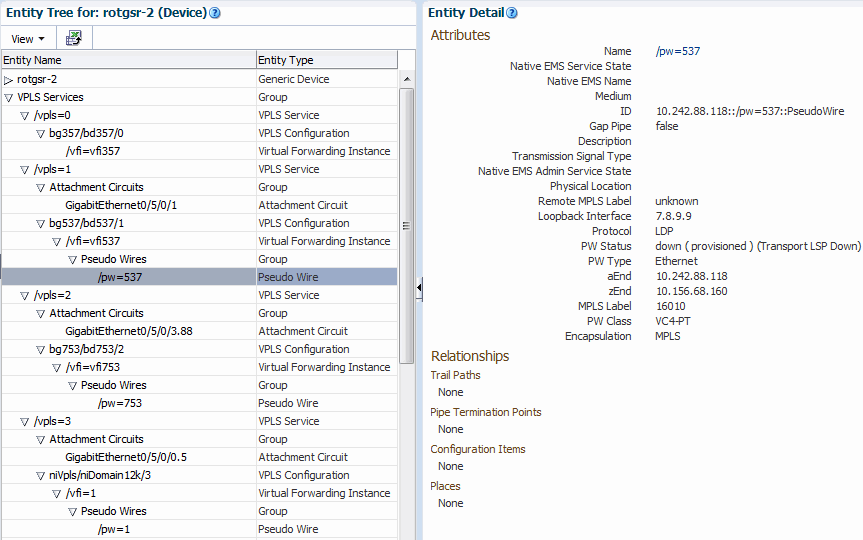
Description of "Figure 3-6 Sample Discovered Data for a Pseudo Wire"
Design Studio Construction
This section provides information about the composition of the VPLS reference cartridge from the Oracle Communications Design Studio perspective.
Model Collections
Table 3-8 shows the model collection used in the VPLS reference cartridge.
Table 3-8 VPLS Model Collection
| Specification | OCIM Model Entity Type |
|---|---|
|
Generic Device (ora_ni_uim_device) |
Logical Device |
|
Generic Interface (ora_ni_uim_device) |
Device Interface |
|
VPLS Service |
Inventory Group |
|
VPLS Configuration |
Inventory Group |
|
Virtual Forwarding Instance |
Inventory Group |
|
Attachment Circuit |
Custom Object |
|
Pseudo Wire |
Pipe |
Actions
The following tables outline the Design Studio construction of the VPLS reference actions and associated components:
Table 3-9 VPLS Cartridge Actions
| Action Name | Result Category | Address Handler | Scan Parameter Groups | Processors |
|---|---|---|---|---|
|
Discover Cisco IOS XR VPLS CLI |
Device |
IPAddressHandler |
N/A |
|
Table 3-10 VPLS Cartridge Processors
| Processor Name | Variable |
|---|---|
|
CLI Property Initializer |
See "Table 2-5" for more information. |
|
CLI Property Customizer |
See "Table 2-5" for more information. |
|
CLI Connection Manager |
See "Table 2-5" for more information. |
|
Cisco IOS XR VPLS CLI Device Collector |
Input:
Output: entityList |
|
Cisco IOS XR VPLS CLI Device Modeler |
Input: entityList Output:
|
|
Cisco IOS XR VPLS CLI Device Persister |
Input:
Output: N/A |
Design Studio Extension
This section provides information about Design Studio extensions to the VPLS reference cartridge.
The VPLS reference cartridge contains code used to run CLI commands specific to Cisco IOS XR devices, parse command responses, and model the VPLS service as an unsealed cartridge. You can change any part of the code to customize this cartridge to fit your environment, or you can use the code as an example on which to model your own custom VPLS cartridge. For more information about extensibility, see Network Integrity Developer's Guide and Network Integrity Concepts.
